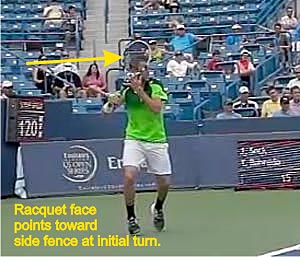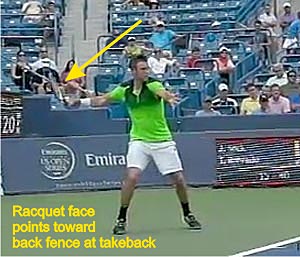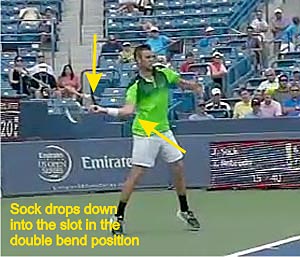|
TennisOne — Western & Southern Open What's Wrong with American Tennis? Jay Margolies What’s wrong with American Tennis (and by this I mean men’s tennis specifically)? Wherever I travel, I seem to come up against this question. And it’s often posed as more of a lament than a complaint — a pining for the glory days. In America, with its can do attitude, there has to be something we can fix to make the world right again. There has to be someone to blame, whether it be the USTA, our coaching methods, or maybe just the Gods, but something. Well,… maybe not. Let's face it, we’ve had an absolutely phenomenal run since the advent of the open era. First there was Jimmy Connors with his gaudy 109 tournament wins including eight slams and then came John McEnroe with seven slams. Both men spent long periods on top of the rockpile. These great champions were followed quickly by, to borrow a phrase from history, “the greatest generation” — Pete Sampras, Andre Agassi, Jim Courier, and Michael Chang. Together they won 27 slams--that’s a lot to live up to for anyone. It certainly placed unfair expectations on the players who came after. Andy Roddick, James Blake, and Mardy Fish had solid careers but nothing like their predecessors and questions began to surface early. There had to be something wrong, there had to be some place to lay the blame. Funny thing is, you might ask the same question in any number of countries. Certainly the Aussies have had reason to pine for the glory days of Hoad, Emerson, Rosewall and Laver, as do the Belgiums since the retirement of Justine Henin and Kim Clijsters. And I wonder what they will be saying in Switzerland once Roger Federer and Stan Wawrinka decide to pack it in. I don’t see anyone else following behind them, at least not yet. The point is all sports are cyclical. The once great Green Bay Packers spent many years in the wilderness before Brett Favre and friends led them back to the promised land, and despite all the success of the New York Yankees and all the money they spread around, Don Mattingly, one of the best players in the league, spent 14 years on the team without once making the playoffs. I realize tennis is not the number one sport in America as it is in many other countries and that the nation's best athletes are often found on the gridiron or the hard wood, but that didn’t stop Sampras and Agassi from reaching the top. So perhaps it is just a cyclical thing and we just have to be patient while we wait for the second coming, so to speak.
Jack Sock As of now, John Isner is the top American, a player who rode his huge serve to a career high number nine in the world in 2012. Since then he’s drifted down to no. 14 and I don’t see this “king of the tiebreakers climbing much higher. Perhaps more intriguing is Jack Sock, a 21 year-old out of Overland Park, Kansas, now living in Lincoln Nebraska. He is listed at 6-1, 180 pounds, but he appears much bigger than that. I first saw Sock play while he was still in high school at Doug King’s invitational tournament in Napa, California, where he held his own against some of the best collegiate players in the nation. At this years Western & Southern Open in Cincinnati, Sock ran up against, veteran Tommy Robredo in the first round, going down 6-7, 3-6. A player like Robredo, much like his countryman, David Ferrer, gives nothing away easily, so you have to convert your opportunities when they arise. Sock had his chances in the first set but couldn’t serve out the tie breaker. He called for a trainer at the break and had his bicep worked on, then went down weakly in the second seemingly suffering from some mysterious ailment. He spent time doubled over between points but never called the trainer back on court. Whatever it was, and since no one seems to be saying, it made it difficult to gauge his growth on basis of this one match. However, there was a lot to like in what I saw, but if he is too climb into the tennis stratosphere, he'll have to make some improvements also. The Good, the Bad, and the Ugly
Sock’s game is built around a huge serve which he seems to lazily and almost effortlessly deliver at speeds of 135 and higher. This is a major weapon to be sure, but what intrigues me most about his game is his forehand, an extremely compact stroke in which he is able to create tremendous racquet head speed with a very short forward movement. It’s what TennisOne contributing editor, Christophe Delavaut, calls the ATP style forehand, where the racquet stays on the same side of the body throughout the backswing. To survive in the modern men's game, where the ball is struck with such great velocity, this abbreviated stroke is a must. Some of the women seem to be moving towards this also (think Samantha Sosur); however, the majority use a much more sweeping takeback than the men like Caroline Wozniaki above. The Sock Forehand
in the photo above (left) you see the classic unit turn — hips coiled, racquet head pointed toward the side fence with the non-dominant hand supporting the racquet. In the takeback position (right), the racquet face points toward the back fence and the racquet remains on the same side of the body throughout the stroke.
In the slot, Sock drops into the classic double bend position which he maintains through out contact. The stroke is short and compact yet he is able to generate tremendous racquet head speed as he uncoils into the contact. Note that the racquet head is pointed slightly downward at contact as he brushes up and lifts the ball over the net.
Big serve, terrific forehand — well that's the good. So is Jack Sock the next great American hero? Not quite yet. While there is a lot to like about his game, there are some weaknesses also. For one thing, his backhand seems to be more of a place holder than a reliable stroke and he runs around it every chance he gets. Most of his errors seem to spring from the backhand side and there were a lot of them. Against a steady, smart player like Robredo, this weakness was on center stage and easily exploitable. Sock could also improve his movement, especially on the backhand side. While he's not among the worst movers on the tour, he in no way resembles Federer or Djokovic either. But then again, who does. So what's the upside for Jack Sock? I've never been a great prognosticator, but as it stands now, like a fine wine, Sock will get better as he matures. I see him settling comfortably inside the top 30; however, with a few improvements to his game, along with the weapons he possesses, he could climb considerably higher. We just have to wait and see. |



